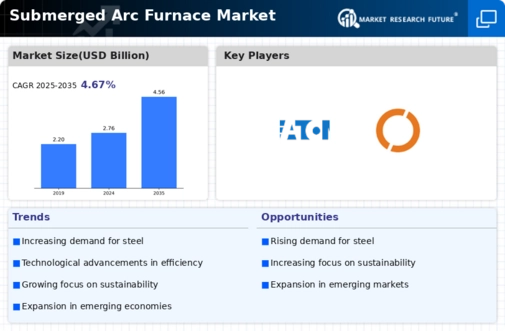Market Growth Projections
The Global Submerged Arc Furnace Market Industry is projected to experience substantial growth, with estimates indicating a market value of 4.56 USD Billion by 2035. This growth trajectory reflects a compound annual growth rate of 4.68% from 2025 to 2035, driven by various factors including technological advancements, rising steel demand, and increased investments in infrastructure. The market's expansion is indicative of the critical role submerged arc furnaces play in the global steel production landscape. As industries evolve and adapt to changing market dynamics, the submerged arc furnace sector is likely to remain a focal point for innovation and investment.
Expansion of Mining Activities
The expansion of mining activities globally is a key driver for the Global Submerged Arc Furnace Market Industry. As mineral extraction increases, the availability of raw materials for steel production, such as iron ore and ferroalloys, becomes more pronounced. This growth in mining not only supports the supply chain for submerged arc furnaces but also enhances their utilization rates. The synergy between mining and steel production is crucial, as it ensures a steady flow of inputs necessary for efficient furnace operations. Consequently, the market is poised for growth as mining activities continue to expand, meeting the rising demand for steel.
Rising Demand for Steel Production
The Global Submerged Arc Furnace Market Industry is experiencing a surge in demand driven by the increasing need for steel production. As economies grow, the construction and automotive sectors expand, leading to higher steel consumption. The submerged arc furnace technology is favored for its efficiency in producing high-quality steel, which is essential for various applications. In 2024, the market is projected to reach 2.76 USD Billion, reflecting the industry's pivotal role in meeting global steel demands. This trend is expected to continue, with projections indicating a market value of 4.56 USD Billion by 2035, showcasing a robust growth trajectory.
Growing Focus on Sustainable Practices
The Global Submerged Arc Furnace Market Industry is witnessing a shift towards sustainable practices, driven by environmental regulations and corporate responsibility. Manufacturers are increasingly adopting submerged arc furnaces that utilize alternative raw materials and energy sources, thereby reducing their carbon footprint. This trend aligns with global initiatives aimed at promoting cleaner production methods. The emphasis on sustainability is likely to attract investments and foster innovation within the industry. As companies strive to meet stringent environmental standards, the demand for efficient and eco-friendly submerged arc furnaces is expected to rise, further propelling market growth.
Technological Advancements in Furnace Design
Innovations in submerged arc furnace technology are significantly influencing the Global Submerged Arc Furnace Market Industry. Enhanced designs improve energy efficiency and reduce operational costs, making these furnaces more attractive to manufacturers. For instance, the integration of automation and advanced control systems allows for better monitoring and optimization of the smelting process. These advancements not only enhance productivity but also contribute to sustainability efforts by minimizing emissions. As the industry evolves, the adoption of these technologies is likely to drive market growth, aligning with the increasing regulatory emphasis on environmental standards.
Increasing Investments in Infrastructure Development
The Global Submerged Arc Furnace Market Industry is significantly influenced by rising investments in infrastructure development across various regions. Governments and private sectors are channeling funds into large-scale projects, including transportation, energy, and urban development. This surge in infrastructure spending creates a robust demand for steel, which is a primary output of submerged arc furnaces. As nations prioritize infrastructure to stimulate economic growth, the market is expected to benefit from this trend. With projections indicating a compound annual growth rate of 4.68% from 2025 to 2035, the industry is well-positioned to capitalize on these investments.













Leave a Comment